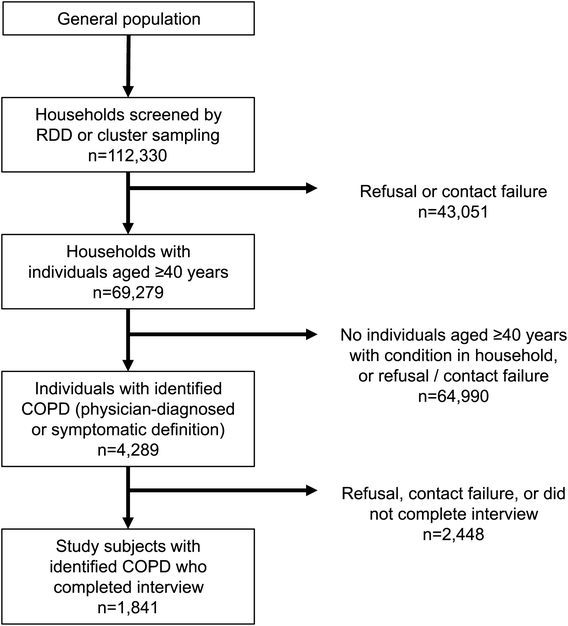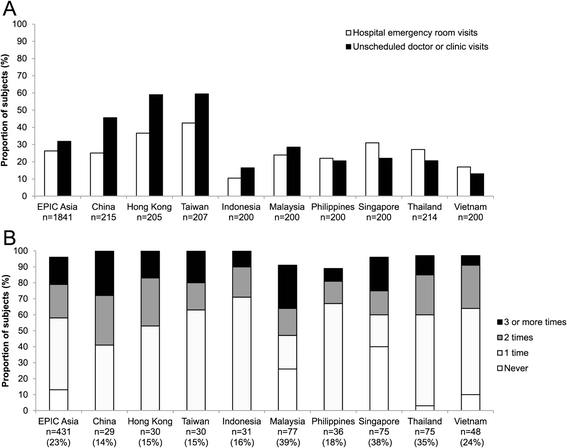Impact of chronic obstructive pulmonary disease (COPD) in the Asia-Pacific region: the EPIC Asia population-based survey
- PMID: 25937817
- PMCID: PMC4416253
- DOI: 10.1186/s12930-015-0020-9
Impact of chronic obstructive pulmonary disease (COPD) in the Asia-Pacific region: the EPIC Asia population-based survey
Abstract
Background: Chronic obstructive pulmonary disease (COPD) is a clinical syndrome encompassing a group of chronic, progressive, and debilitating respiratory conditions, that are characterized by incompletely reversible airflow limitation. Within the Asia-Pacific region, prevalence estimates have been derived using various protocols and study methods, and there is little data on the impact of COPD exacerbations. This study aimed to provide a comprehensive picture of the current prevalence and burden of COPD in this region.
Methods: A population-based survey was conducted in nine Asia-Pacific territories between 01 February 2012 and 16 May 2012. Overall, 112,330 households were screened to identify eligible subjects (aged ≥40 years, with a physician diagnosis of COPD, chronic bronchitis or emphysema, or with identifiable symptoms of chronic bronchitis). Out of a sample of 69,279 individuals aged ≥40 years, 4,289 subjects with COPD were identified. Data were collected via face-to-face interviews or by fixed-line telephone, using a structured questionnaire. A total of 1,841 completed questionnaires were analyzed.
Results: The overall estimated COPD prevalence was 6.2%, with 19.1% of subjects having severe COPD. In the 12 months prior to the survey, nearly half of all subjects (46%) had experienced exacerbations, and 19% had been hospitalized as a result of their condition. When subjects were asked about the impact of their condition on employment, 23% said their condition kept them from working, and 42% felt that their condition limited their ability to work or their activities. Of those who reported taking prescription drugs, 20% did not know the name of the drugs they were taking. Prescription of oral corticosteroids was common, with 44% of subjects having used these during the previous year to manage their respiratory symptoms; in contrast, inhaler use was low (25%). Only 37% of subjects had taken a lung function test, and the majority (89%) of those tested did not know their test results.
Conclusions: Across the Asia-Pacific territories surveyed, the prevalence of COPD is high, indicating a substantial socioeconomic burden. Our findings suggest that there is considerable room for improvement in the management of COPD, and highlight a need to enhance patient and physician education in the region.
Keywords: Asia-Pacific; Chronic obstructive pulmonary disease (COPD); Exacerbations; Impact; Population-based; Prevalence; Quality of life (QoL); Survey.
Figures






References
-
- World Health Organization: Global burden of disease 2004 update. Available from: http://www.who.int/healthinfo/global_burden_disease.
-
- The Global Initiative for Chronic Obstructive Lung Disease (GOLD): The Global Initiative for Chronic Obstructive Lung Disease (GOLD) Global Strategy for the Diagnosis, Management, and Prevention of Chronic Obstructive Pulmonary Disease, Revised 2013. Available from: http://www.goldcopd.org. - PubMed
LinkOut - more resources
Full Text Sources
Other Literature Sources

